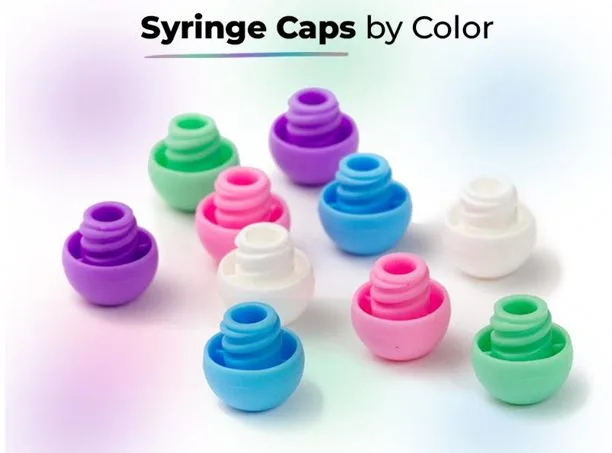Choosing Syringe Caps by Color: Key Considerations for Medical, Veterinary, and Dispensary Needs
Consider it, when in the midst of a busy shift, of looking up a dosage, prepping an IV flush, do you really have time to stop and double-check every detail? That issue is addressed by using color-coded syringe caps. They are more about safety, clarity and speed.
What is it about the colors of syringe caps that matters so much to different industries? And how do you choose what works best for your setup?
Let us dive into it.
Medical Needs
The colored syringe caps in the hospitals, clinics, surgical centers facilitate work and minimize danger. Colour in certain cases may be an indication of a given substance or process.
For example:
- Red caps could be assigned to harmful medications or emergency medication.
- Blue or white caps are often seen with saline or flushes.
- Yellow caps could point to hazardous waste or chemo-prepped syringes.
This is with the presence of so many medications and treatments in the market, color-coding works as a visual safety net. It helps nurses and techs grab the right item fast—no need to squint at tiny labels.
Bottom line: When color is the function , the correct use of caps can actually save lives.
Veterinary Needs
Whoever has ever worked in a vet clinic knows, it gets chaotic. Animals don’t wait politely for you to label everything. It is the reason why color-coded syringe caps may become a breakthrough in veterinary practice.
Different species, sizes, and dosage levels imply that you require a reliable system. Here’s what some clinics do:
- Green caps for small pets.
- Purple for large animals.
- Orange for sedatives.
- White for general-purpose saline.
Even color can prevent cross-contamination.
Dispensary Needs
The cannabis industry has its demands regarding syringes and caps- especially in medical-use states where compliance is everything. Much of the dispensaries have syringes that are used to dispense oils, concentrates, and tinctures.
Here, syringe cap color helps with:
- Product identification (THC vs CBD, full-spectrum vs isolate).
- Dosing consistency.
- Customer safety.
It is simply good branding. Many companies match cap colors with packaging or strain types. It not only appears professional, but helps the users recall what’s what.
As regulations become stricter in most states, an easy-to-audit and impossible to misread system is essential. And all that begins with a simple cap.
Color Considerations
This is what you should know in selecting syringe caps by color:
Material Matters: Not every cap is equal. Some are designed for high-temp sterilization. Others are single-use only. Ensure that the cap you pick is suitable for the syringe and application.
Cap Fit: A loose cap is a hazard. Seek a secure seal by looking at luer-lock or slip-tip compatibility. Some caps also have tamper-evident features.
Sterility: If you’re using the syringe for injection or sterile dosing, make sure your caps are sealed, sterile, and clearly marked. Non-sterile caps are fine for some dispensary uses, but not for clinical or surgical applications.
Final Thoughts
Syringe caps might seem like an afterthought, but they play a real role in safety, speed, and organization. Whether you’re a nurse loading emergency meds, a vet handling a stressed-out husky, or a dispensary tech prepping orders, cap color helps keep everything running smooth.
So yeah, the color of that tiny piece of plastic? It matters more than you think.
FAQs
Q: Can I reuse syringe caps?
A: It depends. In non-sterile settings like dispensaries, caps can be reused if cleaned. In medical or vet environments, single-use is safer and more compliant.
Q: Are there universal color standards?
A: Not yet. Hospitals and clinics often develop internal standards. However, some are moving toward more consistent coding, especially for hazardous meds or specific substances.
Q: Do color-coded caps help reduce medication errors?
A: Yes, absolutely. Studies show that visual cues—like cap color—can reduce prep time and prevent mix-ups, especially during emergencies.
Q: How do I know if a syringe cap is sterile?
A: Check the packaging. Sterile caps are usually sealed individually or in sterile packs and are labeled as such. If it doesn’t say “sterile,” it probably isn’t.





